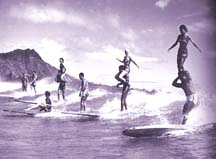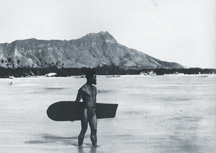
Hawai'i Visitors Bureau
Synchronized Surfing: Diamond Head (left) looms over some imaginative piggy-back wave riders in the 1950s.
A reprinted classic searches for the origins of wave-riding
By Michael S. Gant
MORE THAN just another sport, surfing is a cultural construct whose impact can be traced in the ripples it generates in the language. Attempting to impress upon a reporter his excitement over the interactivity of the new Microsoft/NBC prime-time news show, talking head Brian Williams gushed, "I'm waxing up my keyboard to surf the net." The metaphor works, even if one suspects that the NBC correspondent wouldn't go near a beach unless there were an amphibious assault to cover.
I'm convinced that much of the success of the Internet and the World Wide Web can be attributed to the felicitous use of the surfing metaphor. Consider "Surfing on the Internet, "A Beginner's Guide to Surfing the Net" and "The Kid's Guide to Surfing Through Cyberspace," to quote a few recent book titles at random.
The notion that a person can be skimming skillfully across oceanic waves of globally linked information, executing virtual turns and digital dips, while actually "sitting on his butt" in front of a computer (as Sparky the Penguin once sneered in a This Modern World cartoon by Tom Tomorrow about the cyber revolution) elevates nerdism to athleticism with the stroke of a keyboard. What was once called research--and sounded rather stodgy and boring--has been rendered hip by linguistic association with the endless-summer existence of wave junkies who wouldn't be caught dead in Fry's.
Indeed, "surfing the net: the concept" possesses enough talismanic power to redeem the other, less appealing, application of the metaphor: channel surfing. To sink into a couch, exercising no more than one's thumb on the remote, while surfing across the illusory plenitude of network and cable TV (the more channels, the fewer programs worth watching--Murdoch's Law) carries precious little cachet, even if a trend-spotter like Douglas Rushkoff, in his new book Playing the Future, praises channel surfing as the next generation's way of "embracing chaos" and accepting "the discontinuities of time and personalities."
The impending chaos of a discontinuous future is likely to deploy a surfing metaphor as well. A street prophet underneath the office window where I used to work years ago liked to inform passersby in a loud voice that the world would end not with a bang but with "500-foot waves" and that we've all be "surfing across the bay." His prophecy has come true in John Carpenter's latest film, Escape From L.A., in which Kurt Russell and Peter Fonda ride an apocalyptic wave through the City of Angels.

Retro surf music is totally gnarly, dude.

IN THE mid-'60s, when I was an Orange County teenager, surfers still competed for trophies, not tropes. Anxious to be cool, my friends and I absorbed our surfing lore from the music and the movies. Although we knew from watching Ride the Wild Surf, starring Fabian, Tab Hunter and one vaguely Polynesian-looking extra, that surfing's best waves broke on the north shore of O'ahu, we were, for the most part, unaware of the sport's rich past. For all we cared, Dick Dale had invented surfing.
If we had bothered to dig a bit deeper (doing some of the then-fashionable "research"), we might have discovered Surfing, the Sport of Hawaiian Kings, published in 1966 and written by Ben Finney, who initiated the project as his master's thesis at the University of Hawai'i, and James D. Houston, a Santa Cruz novelist.
Now reissued (and slightly retitled) in a copiously illustrated new edition with a new foreword by the authors (Houston lives within easy walking distance of Santa Cruz's Twin Lakes Beach, where the surf reached Hawaiian proportions in late July; Finney is a professor at the University of Hawai'i), Surfing: A History of the Ancient Hawaiian Sport chronicles the social and cultural roots of wave-riding, from its ancient origins in Polynesian society through its heyday and decline in Hawai'i up to its resurgence as a vital expression of indigenous Hawaiian culture.
After a brief introduction to the ingredients of the sport, Finney and Houston delve into its obscure roots. Throughout the islands of the Pacific, rudimentary board riding for fun probably dates back as far as 2,000 B.C.E. Although Polynesians must have experimented with a variety of wave-riding techniques, living as they did in such intimate contact with the sea, it was the Hawaiians, the authors speculate, who pioneered the unique skill of standing upright on a large board ahead of the crest of a rushing wave.
What was primarily a child's sport in most of the Pacific region, requiring no more than a belly, or paipo, board, became a pastime of serious intent for adults in Hawai'i. Scouring the reports of early explorers in the region, Finney and Houston note that only the Hawaiians possessed boards substantial enough (the olo, 18 feet long, 2 feet wide and 5 or 6 inches thick) to carry a standing surfer on a wave. (In an interesting detour, the authors search for independent surf cultures and discover two possibilities: Northern Peru and West Africa.)

Hawai'i Visitors Bureau
HORSE RACING may be the sport of kings, but in Hawai'i, surfing was the land of sporting kings. Hawai'i's rulers demonstrated their superiority to the physical labor of commoners by devoting themselves to the art of surfing--it was a way of establishing their status. As a badge of their position, only the chiefs were allowed to ride the olo, and certain breaks were reserved for the elite.
"In religion, in language, in festivals, in love, and in song and story," Finney and Houston write, "surfing was woven into the life of ancient Hawai'i." A mere sport might have survived the arrival of Europeans, but surfing was too much part of the old social order to weather the devastating impact of the colonialists and missionaries who inundated the islands in the wake of Captain Cook's expedition.
Ironically titled, "The Touch of Civilization" chapter details the process by which the native Hawaiians were shorn of their cultural heritage in order to become Westernized. Finney and Houston, attuned to historical subtleties, recognize that the transformation was as much a seduction as a conquest: "That these foreigners could be so powerful and wealthy without respecting the kapu system, the sacred taboos that had regulated every aspect of island life, led daring Hawaiians to flout specific prohibitions until finally, the king uprooted the entire system."
The blandishments, temptations and puritanical strictures of the missionaries killed off Hawaiian sports like surfing (which wasn't just frivolously pleasurable but actually carried an erotic charge in its free mixing of the sexes) and stifled native musical traditions. By the turn of this century, the ancient frolic of Hawai'i's kings and commoners was barely a memory, a point poignantly summed up by a magnificent full-page photograph of a lone late-19th-century native surfer headed out to sea at Waikiki beach--he looks like the last of his kind.
Appropriately enough, it was a Californian, Jack London, who kicked off the sport's revival with his 1907 report of a day of wave riding. His gambol in the surf took place during his Pacific Islands cruise aboard the Snark and was recounted in his article "A Royal Sport," published in, of all places, A Woman's Home Companion. London models his surf wear while wife Charmian protects herself from the sun with a large parasol in an amusing 1915 photograph reproduced in the book. More pragmatically, early developers of the Hawaiian beach-front hotels recognized that surfing was a tourist attraction that could help promote their fledging resort ventures.
For the most part the surfing revival, nurtured by sporting groups like the Hawaiian Outrigger Canoe Club and by the charismatic surfer and Olympic swim champion Duke Kahanamoku, was confined to the Waikiki tourist beaches. After World War II, however, mainlanders, Californians in particular, started to arrive in, well, waves. (Three Hawaiian princes--Jonah Kukio Kalaniana'ole and his brothers, David and Edward--actually demonstrated some wave-riding techniques in Santa Cruz in 1885, but the seed they planted in the locals took half a century to germinate, apparently.)
Spurred by the interest of new devotees, the surfboard began to mutate, becoming shorter, smaller and lighter as it shifted from redwood and pine construction to balsa-fiberglass and plastic foamfiberglass. The evolution is nicely illustrated in a graph that shows the shape of board across time, not unlike those charts that depict the emerging upright posture of our humanoid ancestors.
Finney and Houston end their narrative at about the time classic surf music was peaking and before the full arrival of the modern revolution in short-board design. Just before, in other words, the cycling of retro-surfing nostalgia that spawned everything from John Milius' absurdly mythologizing 1978 film Big Wednesday to such musical mutations as Los Straightjackets, a group that performs surf music while wearing Mexican wrestling masks.
In a quieter way, the resurgence of interest in slack key guitar and the documentaries of filmmaker Eddie Kamae are helping to preserve--not as nostalgia but as living history--Hawai'i's musical traditions. Surfing: A History of the Ancient Hawaiian Sport does the same for the timeless art of wave riding.
Surfing: A History of the Ancient Hawaiian Sport by Ben Finney and James D. Houston; Pomegranate Artbooks; 117 pages; $25 paper.
[ Metro | Metroactive Central | Archives ]
